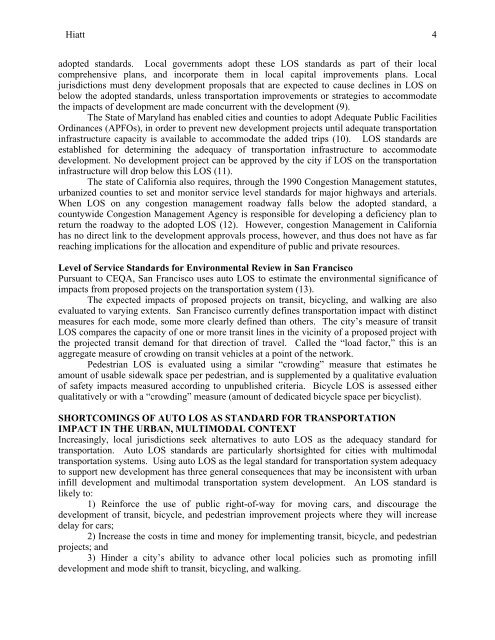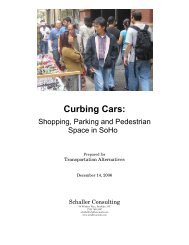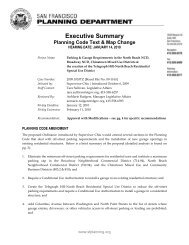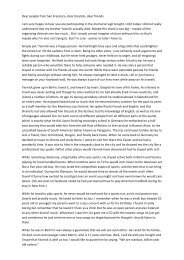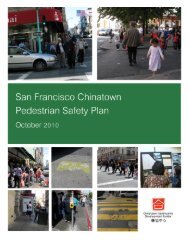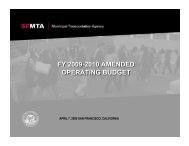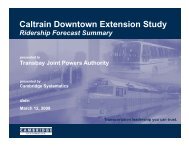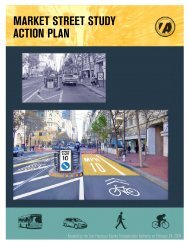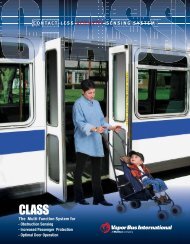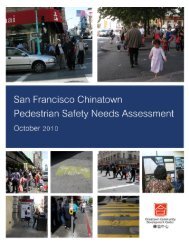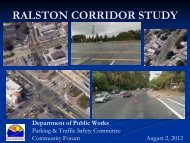Alternatives To Auto LOS For Impact Analysis 111505
Alternatives To Auto LOS For Impact Analysis 111505
Alternatives To Auto LOS For Impact Analysis 111505
Create successful ePaper yourself
Turn your PDF publications into a flip-book with our unique Google optimized e-Paper software.
Hiatt 4<br />
adopted standards. Local governments adopt these <strong>LOS</strong> standards as part of their local<br />
comprehensive plans, and incorporate them in local capital improvements plans. Local<br />
jurisdictions must deny development proposals that are expected to cause declines in <strong>LOS</strong> on<br />
below the adopted standards, unless transportation improvements or strategies to accommodate<br />
the impacts of development are made concurrent with the development (9).<br />
The State of Maryland has enabled cities and counties to adopt Adequate Public Facilities<br />
Ordinances (APFOs), in order to prevent new development projects until adequate transportation<br />
infrastructure capacity is available to accommodate the added trips (10). <strong>LOS</strong> standards are<br />
established for determining the adequacy of transportation infrastructure to accommodate<br />
development. No development project can be approved by the city if <strong>LOS</strong> on the transportation<br />
infrastructure will drop below this <strong>LOS</strong> (11).<br />
The state of California also requires, through the 1990 Congestion Management statutes,<br />
urbanized counties to set and monitor service level standards for major highways and arterials.<br />
When <strong>LOS</strong> on any congestion management roadway falls below the adopted standard, a<br />
countywide Congestion Management Agency is responsible for developing a deficiency plan to<br />
return the roadway to the adopted <strong>LOS</strong> (12). However, congestion Management in California<br />
has no direct link to the development approvals process, however, and thus does not have as far<br />
reaching implications for the allocation and expenditure of public and private resources.<br />
Level of Service Standards for Environmental Review in San Francisco<br />
Pursuant to CEQA, San Francisco uses auto <strong>LOS</strong> to estimate the environmental significance of<br />
impacts from proposed projects on the transportation system (13).<br />
The expected impacts of proposed projects on transit, bicycling, and walking are also<br />
evaluated to varying extents. San Francisco currently defines transportation impact with distinct<br />
measures for each mode, some more clearly defined than others. The city’s measure of transit<br />
<strong>LOS</strong> compares the capacity of one or more transit lines in the vicinity of a proposed project with<br />
the projected transit demand for that direction of travel. Called the “load factor,” this is an<br />
aggregate measure of crowding on transit vehicles at a point of the network.<br />
Pedestrian <strong>LOS</strong> is evaluated using a similar “crowding” measure that estimates he<br />
amount of usable sidewalk space per pedestrian, and is supplemented by a qualitative evaluation<br />
of safety impacts measured according to unpublished criteria. Bicycle <strong>LOS</strong> is assessed either<br />
qualitatively or with a “crowding” measure (amount of dedicated bicycle space per bicyclist).<br />
SHORTCOMINGS OF AUTO <strong>LOS</strong> AS STANDARD FOR TRANSPORTATION<br />
IMPACT IN THE URBAN, MULTIMODAL CONTEXT<br />
Increasingly, local jurisdictions seek alternatives to auto <strong>LOS</strong> as the adequacy standard for<br />
transportation. <strong>Auto</strong> <strong>LOS</strong> standards are particularly shortsighted for cities with multimodal<br />
transportation systems. Using auto <strong>LOS</strong> as the legal standard for transportation system adequacy<br />
to support new development has three general consequences that may be inconsistent with urban<br />
infill development and multimodal transportation system development. An <strong>LOS</strong> standard is<br />
likely to:<br />
1) Reinforce the use of public right-of-way for moving cars, and discourage the<br />
development of transit, bicycle, and pedestrian improvement projects where they will increase<br />
delay for cars;<br />
2) Increase the costs in time and money for implementing transit, bicycle, and pedestrian<br />
projects; and<br />
3) Hinder a city’s ability to advance other local policies such as promoting infill<br />
development and mode shift to transit, bicycling, and walking.


